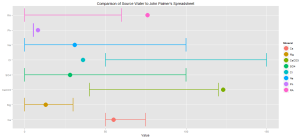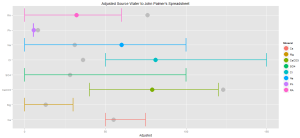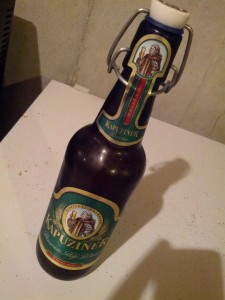Tag Archive: John Palmer
Water Part Drei
I brewed last weekend, and somehow my efficiency was way up.
YES HELLO!
I blame this on Bru'n Water – I tried it instead of Palmer's spreadsheet, and it told me to use a fuckton more acid. #homebrew pic.twitter.com/x2HOSn7udq
— Andrew Rohne 🍺🏃🍕 (@HamBrew807) February 4, 2017
According to BeerSmith, my mash efficiency is 87% and my overall brewhouse efficiency is 97%. I don’t believe that second number at all, but the first is pretty damn important to me, and it is wildly better than what I’ve done in the past.
I took one of my last recipes – an IIPA where I got 60% mash efficiency – and took a look in Bru’n Water. Using my water report found on the Internet and what I added based on Palmer’s spreadsheet, my mash pH was likely close to 5.68 after the 4 grams of gypsum and 1 mL of lactic acid. What I should have done was 4 grams of gypsum and 4.5 mL of lactic acid. That would have put my mash pH around 5.34.
Of course this could be a fluke. I did mash in high (the strike water started at 158ºF, I stirred it down to 155ºF), so there could be that. So there will be a part 4 and a part 5. One will be with a past recipe with a revised water adjustment profile, and another will be about my Ward Labs report… once I run a Ward Labs report!
Cheers!
Down The Rabbit Hole of Water Adjustments
Where I got started on this subject
This all started when I saw a blog post on Practical and Low Cost Water Adjustments. The author there is pretty convincing on the importance of this. Following links from that site, I found this. “Rerun” claims to live “just inside of Clermont County, about a mile east of Beechmont Ford”. I happen to live 5 miles east of Beechmont Ford. Our water in Clermont County comes from three sources and goes into a common distribution system (in other words, they’re all connected).
Coming Brew Day
I eat a lot of Mexican food (well, perhaps “Mexican inspired and styled American food”), and I know that two styles seem to work best: Amber Ale and Vienna Lager. I decided to go with a lager since my fermentation chamber is going to become a keezer. I happen to also see a traditional Vienna Lager on Five Blades Brewing’s website.
Due to availability, I had to substitute Carafa II for the Blackprinz,and carapils for carafoam (there is a lengthy discussion on the difference here). I also added and extra half of a pound of Vienna to compensate for the slightly lower efficiency of my system.
Looking at my source water compared to what John Palmer’s spreadsheet says to use, I’m in range for most of the minerals except for being low on chloride and high on hardness (both calcium carbonate and residual alkalinity).
Water Adjustments
I got John Palmer’s water spreadsheet from the BrewLab kit website. It’s an older version, an updated one is on the How To Brew website. The spreadsheet is fairly easy to use – select a style (from the 2008 styles, not a big deal, really), input my source water info (the boxes are YELLOW), input my RA (I used 0) and my strike water (3.53 gallons). I skipped dilution (left the rate at 0%). The next parts – mineral additions, acid, and results all work together – I looked at where I wasn’t in the range – which was only chloride, and added a gram of a mineral that provides chloride. That mineral is canning salt (NaCl, sodium chloride), so after adding a gram I noticed I was near the middle of the chloride range without exceeding the sodium range (up to 100 ppm). I also saw that total alkalinity was too high (by a measly 3 ppm), but that kept the residual alkalinity up high (76 compared to 0-60) which appears to cause the beer to be darker than expected (and this is expected, as I think all my beers have been darker than I planned). I added a milliliter of 88% lactic acid which reduced the total alkalinity to the middle of the range and the color to 7 – 14 SRM (the target is 10-16, the beer as planned is 10.4 SRM).
Finally, I went down to step 8, which is sparge water treatment. I’m sparging with 6 gallons, so I input the recommended 4 ml of lactic acid for my sparge water.
In the end, 1 gram of canning salt (pure sodium chloride) and 1 ml of lactic acid to the strike water, and 4 ml of lactic acid to the sparge water.
I’m typing this on Saturday night and I brew on Sunday. We’ll see how this works out.
Cheers!
New Brewing Prep
I intend to post weekly, and this has been revised at least five times. I hope it is still a coherent post.
I have been figuring out what I need and what I want to do relative to actually brewing beer, and with the help of various posts on various forums, I think I figured out that I am going to start with a starter set that includes a fermenting bucket, bottling bucket, glass carboy, and I think all the tools to make things work. I had settled on it a few days before Labor Day and while browsing the Reddit homebrewing forum late on Monday night I saw a post that indicated most things at that particular webstore were 10% off, so I ‘pulled the trigger’. Happy birthday to me a few weeks early :-). For whatever reason, the “in stock” item didn’t ship until 9/4 late in the evening. It took so long for them to ship the in-stock item that I thought maybe they know that my birthday is around two weeks away and they’re shooting for that to be delivery day. Truthfully, for a first experience it isn’t good (which is why I’m going into great depth to NOT give away who they are, although if they screw up twice the gloves are coming off). I will probably give them another chance, as it’s my first experience and whatnot, but I might be apprehensive of ordering something that I need in a week and probably reserve their second chance for something that I can order two or three weeks out.
There is one shining spot of it – UPS has been getting the 43 pound set from the middle of the country to Ohio at a record speed – within 16 hours (which includes an overnight), they made it from the origin to Toledo, Ohio. They’re trying like Hell (and will most likely be successful) at getting it to me on Monday. Conveniently right after the weekend. Of course it could have been here Friday if it was shipped a day sooner.
In addition to the supplies, I stopped by a local retailer (I don’t want to call them a homebrew shop, since they’re a large eclectic grocery store that happens to have some homebrewing supplies as well as one of the best beer stocks in the region). I quickly located and purchased the LME, DME, yeast, and hops. However, I was a bit disappointed in the hops selection. I was able to find Soriache Ace (bittering) and Cascade (aromatic) hops, but there was a lot of Cascade and some other varieties of almost all aromatic hops – very few bittering hops. Their refrigerator was mostly bare. I’m going to check them again and see if it was just that they had a lot of purchases prior to Labor Day. I also want to check another local homebrew shop or two.
In the meantime, I’ve been saving and washing a lot of bottles. I’ve been on the lookout for “Grolsch Style” bottles, but haven’t found any Grolsch lately (and the last place I bought it at appears to no longer carry it, although they do have the bottle in the picture below). I think I’d prefer those to having to cap bottles, but I know I’m probably going to be using normal bottles for the first batch. And the second. Probably the third too. Most likely even the fourth.
I did wash and remove the painted labels from four Stone bottles. Using the hint provided on Home Brew Talk, I soaked the bottles in Star San (prepared according to the label on the back) for around 22 hours. I was able to wipe all the paint off the Stone IPA bottles with a damp rag. Same with everything that wasn’t blue on their Self Righteous IPA. And the same with everything that wasn’t gold on their Ruination (there is, unfortunately, a lot of gold on those bottles). However, I decided I’d try something abrasive (which happened to be a bar of Lava soap since I was at my utility sink) and it started taking gold off a Ruination bottle, so I took a dish scrubbing pad to those bottles and that took the remaining paint off.
I’m up to around 30 bottles currently, and I probably won’t be bottling my first batch until early October, so I’m probably going to have enough by the time bottle day rolls around. And I’m already dreaming of a keg system and one of those conical fermentors that I’ll probably never actually get in real life.
I’ve already decided my first brew will be the Cincinnati Pale Ale as included on John Palmer’s Website. First off, I live in Cincinnati (a wonderful place to live if you like beer, thanks to Rhinegeist, MadTree, Moerlein, and other breweries), and I like Pale Ales. I will use extracts (mostly because this is my first and I want to make it easy on myself), but I likely will not be using a kit for ingredients because I want control over what I get. I think at some point in the future I will go all-grain, but walk before run.
One thing I think I will be doing prior to brew day is figuring out every little detail for brew day from where things will sit and what will be where when it is used. I figure it might be a smart thing to make sure I don’t get into a position where I have to carry a 30-pound+ vat of boiling wort halfway across the house to dump it into the fermentor… or have to hunt for the fermentor.
/A


